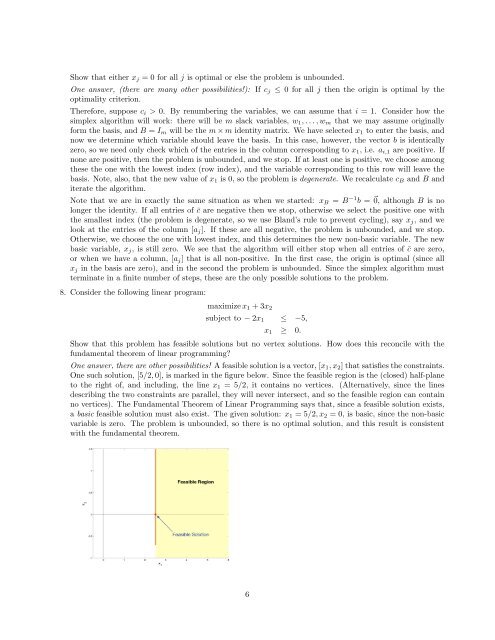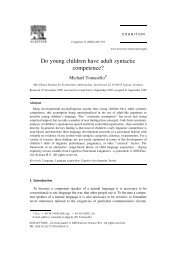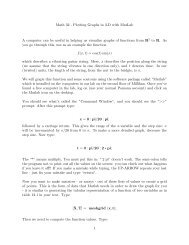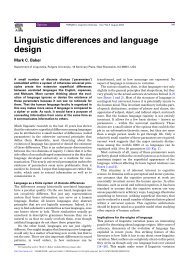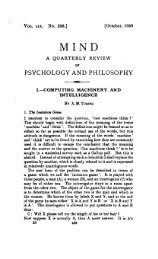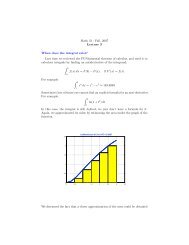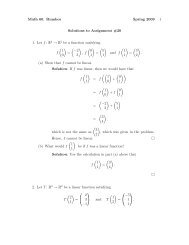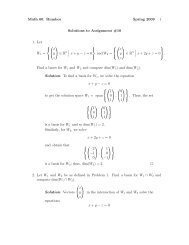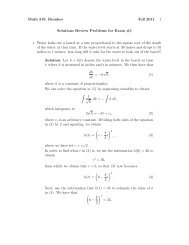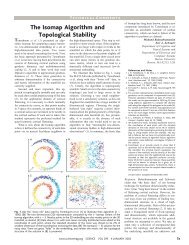Math 187 Solutions to Homework 2: Part 2 Radunskaya 4. Give an ...
Math 187 Solutions to Homework 2: Part 2 Radunskaya 4. Give an ...
Math 187 Solutions to Homework 2: Part 2 Radunskaya 4. Give an ...
You also want an ePaper? Increase the reach of your titles
YUMPU automatically turns print PDFs into web optimized ePapers that Google loves.
Show that either x j = 0 for all j is optimal or else the problem is unbounded.One <strong>an</strong>swer, (there are m<strong>an</strong>y other possibilities!): If c j ≤ 0 for all j then the origin is optimal by theoptimality criterion.Therefore, suppose c i > 0. By renumbering the variables, we c<strong>an</strong> assume that i = 1. Consider how thesimplex algorithm will work: there will be m slack variables, w 1 , . . . , w m that we may assume originallyform the basis, <strong>an</strong>d B = I m will be the m × m identity matrix. We have selected x 1 <strong>to</strong> enter the basis, <strong>an</strong>dnow we determine which variable should leave the basis. In this case, however, the vec<strong>to</strong>r b is identicallyzero, so we need only check which of the entries in the column corresponding <strong>to</strong> x 1 , i.e. a i,1 are positive. Ifnone are positive, then the problem is unbounded, <strong>an</strong>d we s<strong>to</strong>p. If at least one is positive, we choose amongthese the one with the lowest index (row index), <strong>an</strong>d the variable corresponding <strong>to</strong> this row will leave thebasis. Note, also, that the new value of x 1 is 0, so the problem is degenerate. We recalculate c B <strong>an</strong>d B <strong>an</strong>diterate the algorithm.Note that we are in exactly the same situation as when we started: x B = B −1 b = ⃗0, although B is nolonger the identity. If all entries of ¯c are negative then we s<strong>to</strong>p, otherwise we select the positive one withthe smallest index (the problem is degenerate, so we use Bl<strong>an</strong>d’s rule <strong>to</strong> prevent cycling), say x j , <strong>an</strong>d welook at the entries of the column [a j ]. If these are all negative, the problem is unbounded, <strong>an</strong>d we s<strong>to</strong>p.Otherwise, we choose the one with lowest index, <strong>an</strong>d this determines the new non-basic variable. The newbasic variable, x j , is still zero. We see that the algorithm will either s<strong>to</strong>p when all entries of ¯c are zero,or when we have a column, [a j ] that is all non-positive. In the first case, the origin is optimal (since allx j in the basis are zero), <strong>an</strong>d in the second the problem is unbounded. Since the simplex algorithm mustterminate in a finite number of steps, these are the only possible solutions <strong>to</strong> the problem.8. Consider the following linear program:maximize x 1 + 3x 2subject <strong>to</strong> − 2x 1 ≤ −5,x 1 ≥ 0.Show that this problem has feasible solutions but no vertex solutions. How does this reconcile with thefundamental theorem of linear programming?One <strong>an</strong>swer, there are other possibilities! A feasible solution is a vec<strong>to</strong>r, [x 1 , x 2 ] that satisfies the constraints.One such solution, [5/2, 0], is marked in the figure below. Since the feasible region is the (closed) half-pl<strong>an</strong>e<strong>to</strong> the right of, <strong>an</strong>d including, the line x 1 = 5/2, it contains no vertices. (Alternatively, since the linesdescribing the two constraints are parallel, they will never intersect, <strong>an</strong>d so the feasible region c<strong>an</strong> containno vertices). The Fundamental Theorem of Linear Programming says that, since a feasible solution exists,a basic feasible solution must also exist. The given solution: x 1 = 5/2, x 2 = 0, is basic, since the non-basicvariable is zero. The problem is unbounded, so there is no optimal solution, <strong>an</strong>d this result is consistentwith the fundamental theorem.6


